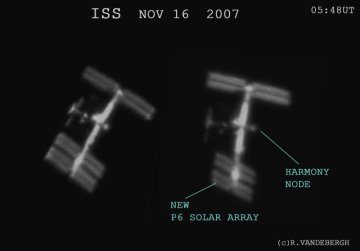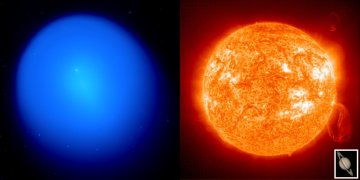 Where's Saturn? Is that a UFO--or the ISS? What's the name of that star? Get the answers from mySKY--a fun new astronomy helper from Meade. Where's Saturn? Is that a UFO--or the ISS? What's the name of that star? Get the answers from mySKY--a fun new astronomy helper from Meade. SUNSPOT ALERT: If you have a solar telescope, point it at the sun. A double-sunspot is emerging in the sun's northern hemisphere. The next 24 hours should be a time of rapid growth and change--worth watching! LEONID METEORS: To people who witnessed the great meteor storms of 1998-2002, the word "Leonid" is synonymous with "spectacular." Alas, this year's display is going to be the opposite. The Leonid debris stream is criss-crossed by rich tendrils of comet dust, but Earth will miss the richest tendrils in 2007. Forecasters expect no more than about a dozen ordinary meteors per hour when the shower peaks before dawn on Sunday, Nov. 18th. UPDATE: On Nov. 14th, Hiroyuki Iida of Japan photogtaphed four early Leonids over the Tateyama mountains, proving that even a few meteors may be worth waking up before dawn to see: animation. SPACE STATION: Early this morning, the International Space Station (ISS) passed over the Netherlands where astrophotographer Ralf Vandebergh was waiting with his camera and a 10-inch telescope. He took these pictures: 
"My images show the station's new Harmony node and the just-unfurled P6 solar array," points out Vandebergh. Harmony was delivered to the ISS earlier this month by space shuttle Discovery and moved into its current location just two days ago by astronauts using the station's robotic arm to wrestle the 30,000-lb module into place. Future shuttles will use Harmony as a docking port. Also, two new science labs (Kibo and Columbus) are scheduled to be attached to Harmony later this year and next, further expanding the ISS and making it an even better target for astrophotography. The ISS is a beautiful sight through backyard telescopes and by naked eye. Would you like to know when the station is about to fly over your backyard? Sign up for Spaceweather PHONE. GIANT COMET: "Formerly, the sun was the largest object in the Solar System," says University of Hawaii astronomer David Jewett. "Now, Comet 17P/Holmes holds that distinction." On Nov. 9th, a team of Hawaii astronomers led by Rachel Stevenson measured the diameter of the comet's expanding debris cloud: 1.4 million kilometers, slightly larger than the sun itself. 
Click on the image for more information
This composite image prepared by Jewett shows a Nov. 9th photo of the comet beside the sun and Saturn for scale. To photograph the comet, Stevenson et al used the 3.6 meter Canada-France-Hawaii Telescope atop Mauna Kea, "one of the few professional instruments still capable of capturing the whole comet in one image," notes Jewett. Comet Holmes exploded on Oct. 23th and it has been expanding ever since. How big will it get? See for yourself. The comet is visible to the naked eye as a fuzzball in the constellation Perseus. With only a backyard telescope you can see the comet's debris cloud in crisp detail and watch it expand from night to night. Nov. 19th is a good night to look: The comet will glide by the star Mirfak (alpha Persei) and appear to swallow it--a sight not to be missed: sky map, ephemeris. Comet 17P/Holmes Photo Gallery
[Interactive World Map of Comet Photos]
[sky map] [ephemeris] [3D orbit] [Night Sky Cameras] | 
